Riding mowers are the best inventions for lawn mowing. Their various designs allow you to use them widely for all types of landscapes. But what is their life expectancy?
Generally, riding lawnmowers last for 6-10 years. But the lifespan can extend to 15 years if properly cared for and maintained regularly. The lifespan of the riding lawnmower depends on various factors like usage frequency, lawn size, type of terrain, and maintenance frequency.
Regular maintenance can extend the lifespan of the mower to a great extent. This article talks in detail about lawnmowers, their lifespan, how to extend their lifespan, and some care tips for a good mower.
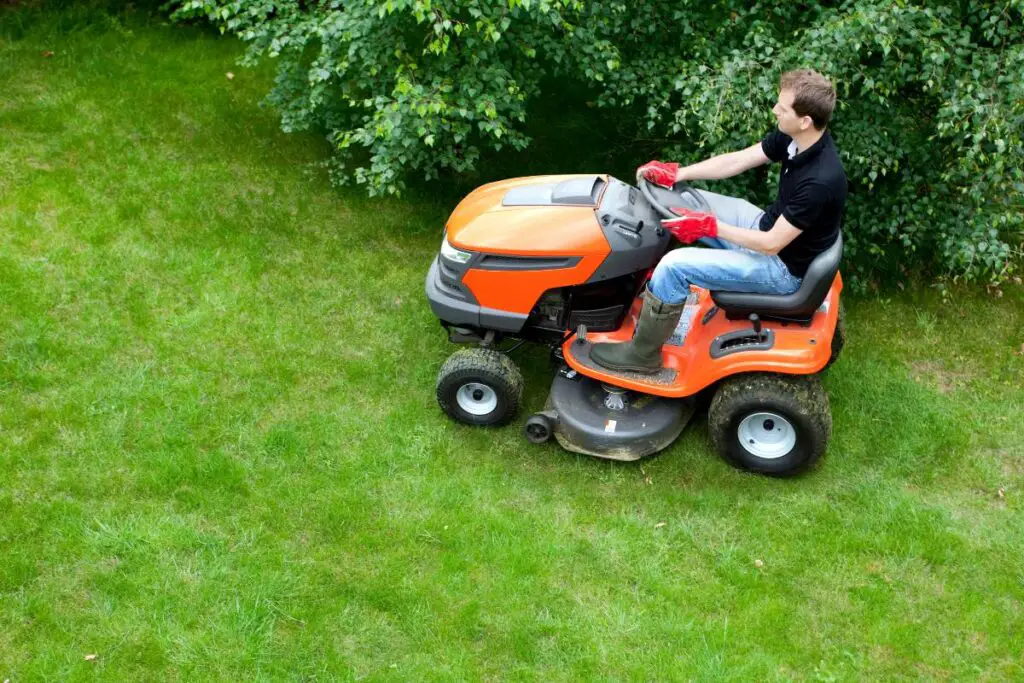
The lifespan of the riding lawnmower: What can you expect?
A typical riding lawnmower lasts up to 10 years. With regular maintenance and checkup, it can last up to 15 years.
But with rough usage, it won’t last up to 10 years.
If you are a frequent mower user like me, measure how many hours the mower will last.
After a little research, I discovered that most riding lawnmowers have a lifespan of around 1,200-1,500 hours or more.
The lawnmowers vary in load-carrying capacity based on the manufacturer and mower size and design.
So, the number of hours differs for all the riding mowers.
The non-commercial riders last for 12 years with regular use.
In commercial machines, the normal lifespan of the riding mower with a normal workload will be 15 years.
The hours will decrease with rough use, lack of maintenance, and overuse.
Here is a small list of various riding mowers and their lifespan according to hours:
- Briggs and Stratton are small-sized lawnmowers for normal workloads. They have an average lifespan of 500 hours and, with proper care, 1,000 hours.
- The John Deere are sturdy machines with 500-1,000 hours of lifespan. The larger mowers with 2-4 cylinder engines have 1,500-2,000 hours of lifespan. It means they will last for 15 years and more.
- The Husqvarna riding mowers last up to 400-800 hours. They are small mowers with small yards.
- The Cub Cadet mowers are the same as the Husqvarna mowers, but their life expectancy is 500-1,000 hours.
The high-end residential riding lawnmowers last an average of 1056 hours.
The commercial ride-ons or stand-on last for 16,500 hours.
The high-end non-commercial brands like John Deere and Husqvarna last for 800 to 2,000 before any major replacement.
For high-end heavy-duty lawn tractors, the lifespan is 16,500 hours or more.
The lifespan of the riding mowers also differs due to the engine type.
Gas-powered riding mowers are powerful due to their engine capacity, fuel type, and number of cylinders.
These mowers range from small single to large double or four-cylinder piston engines.
A single-cylinder riding lawnmower will last up to 500-750 hours.
A larger engine lasts up to 1,500-2,000 hours if maintained properly.
Factors affecting the lifespan of the riding lawnmower
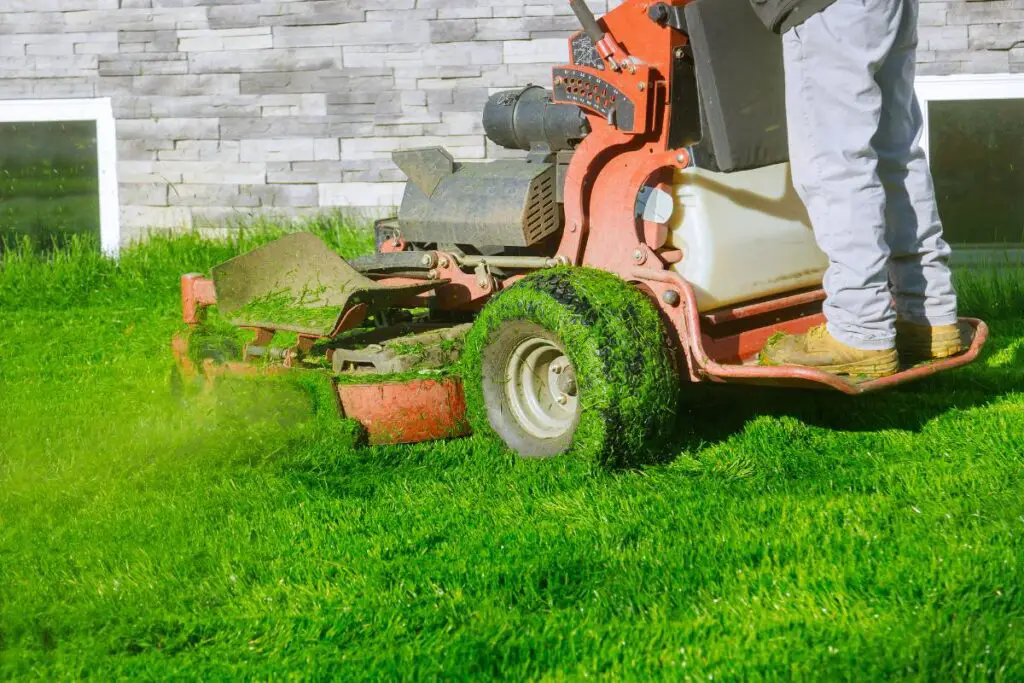
Several factors will either extend or decrease the average lifespan of your riding lawnmower.
Some of these factors are considered issues that contribute to reducing the mower’s lifespan.
Below are some of the major factors:
Frequency usage
The frequency of using the lawnmower highly affects the mower’s lifespan.
Using too much reduces the lifespan, whereas less usage will increase it.
Expect the lawnmower to have a reduced lifespan after using it for hundreds of hours.
A mower used a few times will live longer than one regularly used for longer hours.
Type of terrain
While using riding mowers over bumpy, sloped, or hilly areas, expect a shorter lifespan from your riding lawnmower.
The mower works harder on these terrains to cut the grass.
As a result, the mower parts can wear out faster than normal.
Working on a flat surface is easy as the mowers can run smoothly without extra stress.
If your mower has to deal with slopes and hills, ride them slowly and avoid making sharp turns.
Lawn size

The lawn size also affects the riding mower’s lifespan.
You can run the mower in a small yard for a short time.
A large lawn means you have to run the mower for longer hours.
The size and type of lawn will determine the type of mower too.
For example, if you have rough terrain, you need a heavy-duty riding mower to cut the grass smoothly.
A light-duty mower will take hours to cut. As a result, the mower’s lifespan will be reduced to a great level.
If your lawn has long and thick grass, it will also reduce its lifespan because the mower will overwork to cut them.
Maintenance frequency
When we love something dearly, we always keep it well-maintained to make it last longer. The same is with the riding mowers.
Lack of maintenance will encourage corrosion, weak transmission, smoke and smell, mower not starting or working up to the mark, and many more.
Changing the spark plugs, cleaning the filters, storing the mower well during the off-season, and cleaning the mower after every session are a few common maintenance tips to increase the lifespan.
A riding mower that is taken for maintenance and repair regularly will have a longer lifespan than one that is not maintained.
Mechanical faults
Irregular or no maintenance can lead to several mechanical faults and affect the lawnmower’s overall performance.
The faults can occur from clogged air and fuel filters, bent mower blades, and spark plugs. It can further affect the engine.
Due to these several breakdowns, the mower’s lifespan will be reduced to a great extent.
Looking for gardening supplies? We have tested 100's of products before recommending them to you guys. Check out our best pick below:
| Image | Gardening Supplies | Best Price? |
|---|---|---|
 Top
Top Top
Top | Raised Garden Bed Kit | Check On Amazon |
 | XLUX Soil Moisture Meter, Plant Water Monitor, Soil Hygrometer Sensor for Gardening, Farming, Indoor and Outdoor Plants, No Batteries Required | No Results |
 Top
Top Top
Top | 82 Pcs Garden Tools Set and Extra Succulent Tools Set | Check On Amazon |
 | Joeys Garden Expandable Garden Hose with 8 Function Hose Nozzle, Lightweight Anti-Kink Flexible Garden Hoses, Extra Strength Fabric with Double Latex Core, (50 FT, Black) | No Results |
 Top
Top Top
Top | Dual Chamber Compost Tumbler | Check On Amazon |
 Top
Top Top
Top | Sunnyglade Plant Stakes | Check On Amazon |
 Top
Top Top
Top | Organic Cold Pressed Neem Seed Oil | Check On Amazon |
 Top
Top Top
Top | Mighty Mint Gallon :-Insect and Pest Control Peppermint Oil | Check On Amazon |
 Top
Top Top
Top | Scotts DiseaseEx Lawn Fungicide | Check On Amazon |
 Top
Top Top
Top | Jacks Classic 20-20-20 All Purpose Fertilizer | Check On Amazon |
 Top
Top Top
Top | 30,000 Seeds Pollinator Attracting Wildflower Mixture | Check On Amazon |
 Top
Top Top
Top | Survival Vegetable Seeds Garden Kit-Over 16,000 Seeds | Check On Amazon |
Material quality and manufacturer
Your riding mower’s lifespan depends on the material used for the respective brand.
If the manufacturer and materials used in the mower brand are durable and high-quality, your mower will last long.
You can identify the mower’s sturdiness from the build quality, the design, the mower blades, belts, reels, and bearings.
The manufacturer warranty will also offer some months of use after the purchase.
Storage conditions
Leaving the mower exposed under the sun, uncovered, and not clearing the fuel tank can affect its efficiency and reduce its lifespan.
Storing the mower with fuel in the tank can clog the carburetor and reduce its lifespan.
The rule is to add a stabilizer or empty the fuel tank before storage.
During the off-season, I clean the mower deck, blades, and filters and empty the fuel tank.
I cover the mower well with a mower cover and keep it inside my house at a specific place. You can keep it in a garage or shed.
Better storage enhances the mower’s efficiency and increases its lifespan.
How to extend the life of the riding lawnmower?
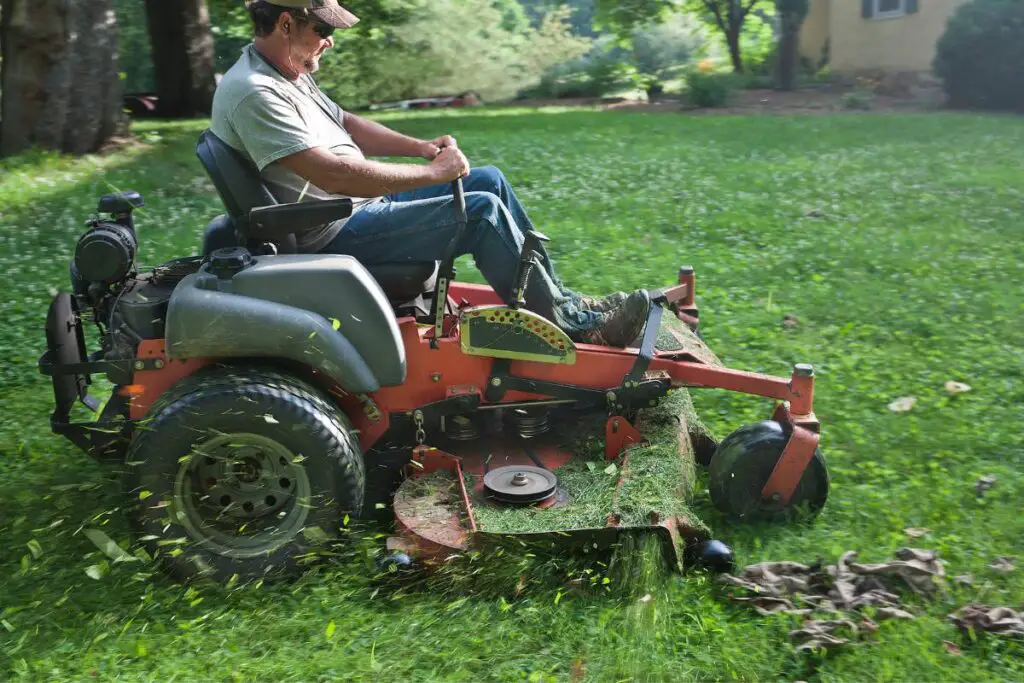
As mentioned earlier, regular lawnmower maintenance can increase efficiency and lifespan.
Regular maintenance is the only key to extending the lifespan of the riding lawnmower.
For proper maintenance, you should perform a full mower inspection:
- Filter change
- Oil change
- Spark plug change
- Axle lube
- Sharpened blades
- Pumped tires
- Deck align
Below are some maintenance tips that will help your mower to remain efficient in the long run:
Use high-quality fuel
Using high-quality fuel can extend the riding mower’s life.
Low-quality fuel mixed with ethanol can damage the rubber and plastic components of the lawnmower.
A good-quality fuel will make your mower run smoothly and efficiently without any issues.
Oil change
Using a mower with a low fuel level can stress the mower as it constantly tries to cut the grass to provide you with appropriate results.
If the mower is new, change the oil every 5 hours.
After 50 hours of usage, change the oil and check the level and color in between to ensure everything is fine.
Check the fuel tank before every use and fill it up at a proper level.
It will let your mower run smoothly without any obstacles.
The care tip is minor but can greatly extend your mower’s lifespan.
Check the tires
Check the air in the mower tires every few weeks and change them whenever you need.
Using deflated tires for mowing can affect the mower’s efficiency and reduce its lifespan.
The recommended tire pressure can vary based on the mower type.
So, check the manual before you inflate your tires.
Filter changes
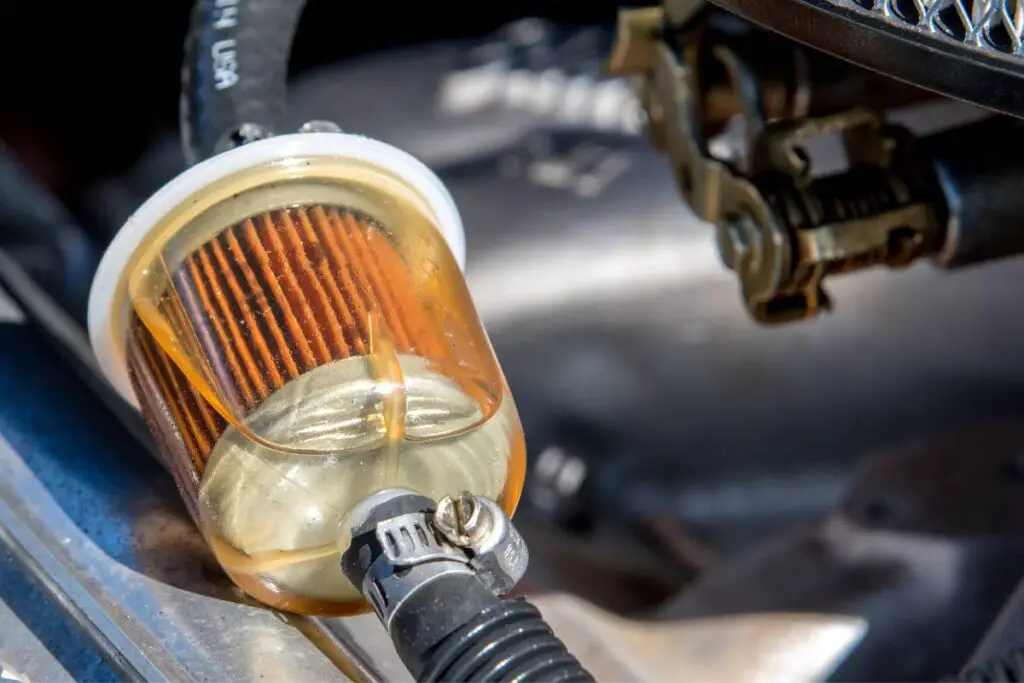
Check the air and fuel filters and clean or replace them regularly.
Blocked filters make the mower work harder and reduce its lifespan.
Cleaning the filters every month will increase the mower’s efficiency and lifespan.
Please change the filters whenever you change the oil, and check them thoroughly whenever you take the mower out.
Deck clean-up
When you mow, the grass clippings accumulate on the deck’s underside.
Clean the deck regularly after every mowing session.
A clogged mower deck makes the engine work harder and reduces the lifespan.
Use a broom or garden hose for cleaning.
It will prevent clogging and keep the mower efficient in the long run.
Decks can sometimes drop at the front time after regular usage.
You may also need to align the deck. Check the tire pressure and set it to 1 bar/15psi.
You will find adjusters at every corner and a lock nut that needs to be released.
Turning these bolts will adjust your mower deck. Spray it with WD40.
Sharpen the blades
Check the blade’s sharpness and replace the blades if they are bent, cracked, or worn out.
If the blades are fine, sharpen them with a good-quality flat metal file.
Blunt blades work harder and end up with uneven cuts. Overwork will reduce the machine’s lifespan.
So, sharpen the blades after every 30 to 40 hours of usage and once per season.
Check the belts
Check the belts. Most riding mowers contain two belts – one for the blades and another for the mower.
The belts should be tight enough and properly greased after regular usage to keep the engine smooth.
Check for wear and tear and replace when needed.
Timely repair and maintenance will increase the mower’s lifespan.
Spark plug replacement
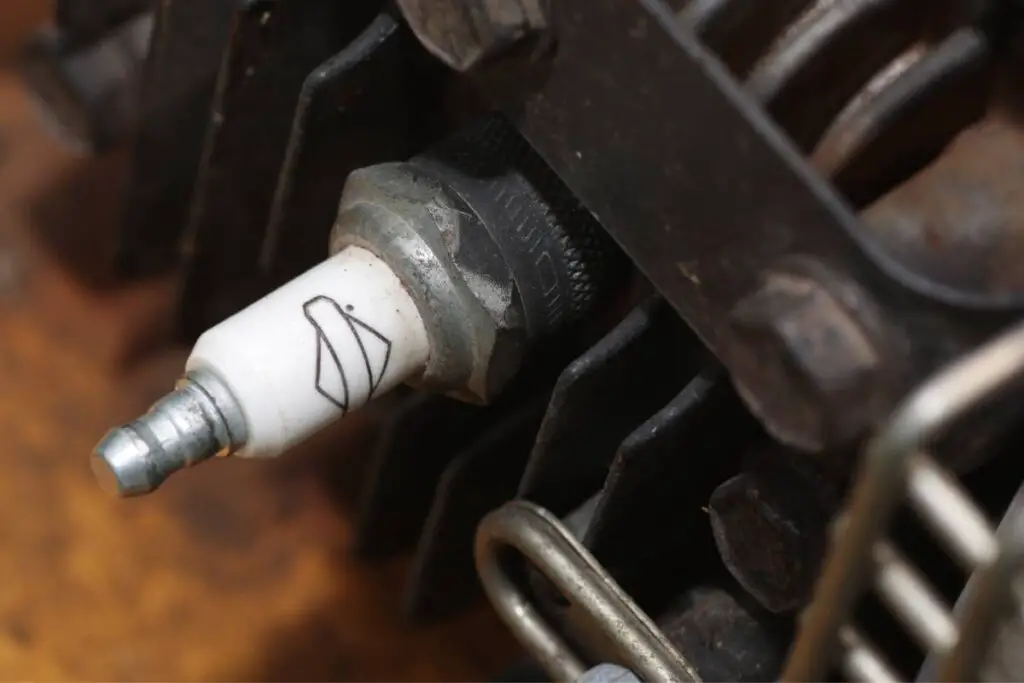
A defective spark plug can reduce the mower’s lifespan and cost you numerous issues, like damage in the cylinders, unburned fuel, and engine life reduction.
You should replace the spark plugs after every 25 hours of usage to increase the mower’s lifespan.
Check the axle lube
Have a look at the rear axle oil level.
The front axle will have greasing points. Oil it with a grease gun for smooth functioning.
Battery maintenance
Maintaining the mower’s battery will keep the machine in good shape in the long run.
Please remove the battery during the off-season and store it in a proper place.
Use a battery charger in maintenance mode to keep the battery in good shape.
Check the water level after 10 hours.
Engine tune-up
Before you begin mowing your lawn, let the mower’s engine warm up a bit.
Tune up the engine once or twice a year for extra safety and a longer lifespan.
A tune-up kit with a wire brush, WD40, flat file, and oil filter will be enough for tuning up the engine.
Clean the mower parts responsible for ignition, air, and fuel systems with these items. Also, lubricate the required parts.
How to store the riding lawnmower during the off-season to prolong its life?
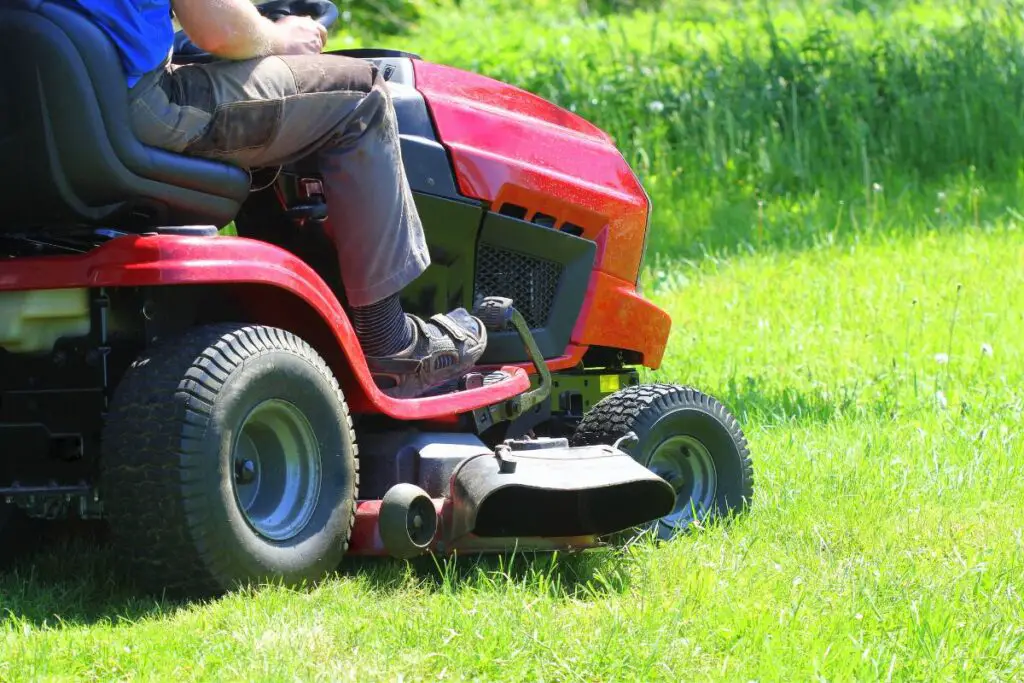
Storing the mower plays a very important role in increasing its lifespan.
Below are the steps to properly store the lawnmower:
- Store the mower in a dry place, like a shed, garage, locker cabinet, or inside the house if you have space. Keeping it outside under the sunlight for a long time can damage the mower’s rubber and plastic components.
- If you want to store the mower for longer, drain the leftover oil after the last mowing session and then store the mower safely.
- Cover the mower safely with a mower cover or tarp to avoid pests entering and nesting inside the machine.
- Add a fuel stabilizer if your fuel tank contains a lot of gasoline. It makes a protective layer for the fuel in the tank and prevents it from worsening. The stabilizer bonds with the gasoline, preventing the moisture from evaporating and the gasoline from forming sticky resins.
- Check the parts of the mower before storage. Clean the deck, discharge chute, and the blades to ensure no grass clippings are left behind.
- Dismantle the mower deck from the mower and store it separately with a dolly.
Importance of using high-quality parts and accessories for your riding lawnmower
The high-end non-commercial brands like the Husqvarna and John Deere can last 2,000 hours or more before you attempt maintenance or replacement.
Using good-quality parts and accessories in the mower can increase its lifespan to a great extent.
Each part of the mower will also have a lifespan. For example:
- The mower engine will last several years if you tune it up regularly and use high-quality engine oil.
- The lead-acid batteries last up to 4 years.
- The carburetor can last up to 5 years.
- The mower blades will run for several years if you keep them sharpened regularly.
If these parts are of high quality, the mower’s lifespan will extend more than expected.
Besides the longevity, there are other reasons to use high-quality parts and accessories:
- Using good-quality mower parts results in better performance of the mower. The parts will work perfectly and also fit your mower.
- Good-quality parts are made of superior materials. As a result, it will increase the efficiency of your riding lawnmower, and you will need fewer repairs and replacements.
- High-quality accessories are safer than cheaper ones. Cheap-quality products are more prone to accidents and safety hazards.
- Though good-quality products will be costly, it is worth it because you don’t have to spend money buying these parts frequently. It will save you money in the long run.
- High-quality products ensure warranty, and the manufacturer confirms the product’s validity to cover any issues. As a result, you can always return to the manufacturer during any failure case.
How to properly clean and maintain the riding lawnmower after each use?
Cleaning and maintaining the lawnmower after every use can increase its lifespan. But how to do it?
Here is what I do to clean my lawnmower after every use:
- Remove all the dirt and debris from the mower with a brush.
- Move to the mower deck and remove all the grass leftovers.
- Check the shields and deflectors to ensure everything is fine.
- The tires must be in good condition and inflated.
- Checking the oil condition and level is important. It will let you know whether you need to change and refuel the tank.
These are the steps after each mowing session.
Now, for a full-on clean-up of the mower, below are the steps I follow before storage:
- Keep the mower on a well-ventilated, flat surface and ensure the parking brake is engaged. Remove the ignition key and disconnect the battery or the spark plug. The blades should completely stop.
- Wash your mower with a pressure washer. Raise the mower front to access the underneath.
- Avoid the electrical parts of the mowers and the bearings.
- Use a multi-purpose detergent to clean the mower deck and tires, and let it stay for 5-10 minutes. After that, rinse it with water.
- Put the mower back on the ground and wash the mower top.
- To wash the engine, use a heavy-duty degreaser.
- After cleaning the mower, keep it in a dry and well-ventilated place to let it dry. Once the mower has dried, store it in a dry place.
Signs your riding lawnmower needs professional maintenance or repair
If you notice something odd about your riding lawnmower, something is wrong.
But how will you understand whether you can solve it or if it needs professional help?
Here are some signs that indicate that your riding mower will need professional help:
- Your lawnmower won’t start or stall. Replacing the spark plug can solve the problem, but if it doesn’t, the engine is the problem, and you need a professional to fix it.
- Oil leaking or smoke from the engine indicates worn-out gear, a loose plug or pan, or a cracked engine. In that case, you should call a professional before your entire mower breaks down.
- If your mower blades are fine but still cut unevenly, the belt or motor power might be the problem. Both will need professional attention.
- Excessive vibration indicates damaged blades or worn-out engine mounts, which only a professional can solve.
- Weird noises signify a problem in the engine which only a professional can solve.
If you find any signs, please consult a professional to fix them soon. Letting the problem stay can reduce the mower’s lifespan.
Eco-friendly tips to extend the life of the riding lawnmower
Regular maintenance can increase your riding lawnmower’s lifespan to a great level.
If you want some eco-friendly tips to keep your mower efficient in the long run, then here are a few of them:
- Maintain your mower regularly by cleaning it often, changing the oil, replacing the filters and the spark plugs, and storing it properly during the off-season.
- Use good-quality fuels like ethanol-free fuels for better performance.
- Store your mower properly in a dry place and avoid sunny spots.
- Avoid overusing or overloading your mower. It puts extra strain on your mower and reduces its lifespan.
- If you suspect any part requires repair or replacement, take immediate steps. Letting the problem stay can reduce the mower’s lifespan and lead to expensive damages later.
Final thoughts
Generally, a mower lasts 10 to 15 years if you take proper care. Regular maintenance is the only key to good longevity. Change the oil, replace the filters, keep the deck clean and aligned, keep the blades sharpened, replace the spark plugs, and tighten the belts.
For storage, use a fuel stabilizer if there are leftovers; otherwise, clean the tank. Keep the mower in a dry place, like a shed or garage, away from the sun, and cover it with a mower cover or tarp.
A yearly engine tune-up and servicing will keep your machine safe in the long run.
Are 600 hours enough for a lawnmower to last?
The highest mileage in the mower with a single cylinder is 500-700 hours. So, 600 hours is enough for a riding mower. But you should maintain it properly to extend the hours more.
What is the best riding mower?
Though many riding lawnmowers are available in the market, some famous mowers are John Deere, Husqvarna, Craftsman, and Toro.
Reference: Riding lawnmower
